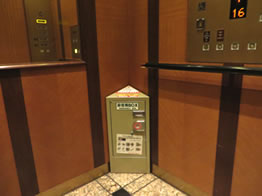 The last letter was from Tokyo and so is this. Tokyo is a rich city and Japan has a rich culture and there is so much to write about. I was staying at a small hotel in Minato-Ku and when I took the elevator to my room I saw metal box pictured above in the corner of the lift. (There is one exactly the same in every lift in this hotel.)
The last letter was from Tokyo and so is this. Tokyo is a rich city and Japan has a rich culture and there is so much to write about. I was staying at a small hotel in Minato-Ku and when I took the elevator to my room I saw metal box pictured above in the corner of the lift. (There is one exactly the same in every lift in this hotel.)
You will probably not be able to read the words from the picture above, but it is an ‘elevator emergency kit’. I have never seen this in any other country (or any other place in Japan for that matter) and it made me think what wonders it might contain. You can see it has a big red button in the middle that you press, hopefully to alert the hotel staff, but also to open the box.
What would you put in an elevator emergency kit? What possible emergencies might happen while you are in an elevator? Fire, maybe. Earthquake certainly. (One shook Tokyo while I was there, it was 05.26 AM, I know that because I was woken up by the bed shaking) However in the event of a fire or an Earthquake, you do not want to be inside the lift and it would stop anyway. So the emergency box should carry something to help you escape the lift – a crowbar? A ladder? Instructions on what to do?
Putting aside these two emergencies, the lift may fail. It might stop unexpectedly. Hopefully it would not plummet downwards, if it did, it would take more than an emergency box in the corner to save you. (I always feel safer in a lift if there is something to hold on to, and I also know that it would not make the slightest difference if the lift descended under the force of gravity, rather than under the influence of excellent engineering principles.) If the lift did stop unexpectedly, and you were stuck between floors, what would you need?
Possibly a torch if the power failed. A screwdriver? A book to read with the torch? Some good music? (Scope for a variation on desert island discs). A sleeping bag? A bottle of water? Maybe even some sweets.
Plenty of possibilities, and it made me think what could be in a coach’s emergency kit, for when coaching breaks down, or gets stuck between floors in a manner of speaking and is not progressing. Let’s look at a possible coaching emergency- you do not know what question to ask next. Here is where you need a you need a backtrack kit. A back track is when you summarise what the client has just said, but you use the clients’ own key words and sometimes key gestures that accompany them. It is not parroting what the client said word for word, (no parrots in the coach emergency kit), but summarising your understanding in a way that relates to the client’s way of thinking. You ensure you use the client’s key words and phrases that pertain to their goals and values. This is a useful move. First of all it demonstrates you have been listening, so you will maintain rapport. Secondly, if you go slightly off from what the client said, they will pick it up and correct you, giving you feedback and clarifying what they said. This will stimulate some new ideas and the session will take off again. Thirdly, if the client agrees with your summary, the act of summarising means you will have gone over what the client said again in your mind, and that is bound to stimulate some new thinking and point a way forward.
The second thing in the coach emergency kit would be a torch – in this metaphor a torch is a question, as questions illuminate the dark places in the client’s mind where they do not look – precisely because they are dark. Here is a couple of emergency questions you might try. ‘I am not sure what to ask you next, what do you think we should pursue?’ and ‘What do you think would be the most useful direction to go now?’ The client knows best, and you are asking them where to go. (However, I would not advise asking, ‘If you were me, what would you ask next?’)
Sometimes clients want to go in a certain direction, but the coach asks another question and the client follows that direction because they think the coach knows best. Coaching is a mixture of support and challenge, sometimes you will move the client along with a challenge, and sometimes you need to metaphorically sit back and let the client drive for a little while.
Finally the coach’s emergency kit should have a piece of adhesive tape. This is to tape over the coach’s mouth to stop them saying anything at all. Sometimes silence is the best question and the best answer to a difficult situation. In music, the notes are defined by the silences in between. In coaching the silences inform and shape the answers. Coaches are often afraid of silence, thinking that nothing is happening and they should be doing something. Silence is where all questions come from, silence itself can be a question. There are many types of silence – a nervous silence if the coach feels they should say something, or a restful silence, waiting to see what will come next.
What other type of emergency might a coach encounter? Perhaps a client who seems to be stuck, not just during a session, but the sessions do not seem to be going anywhere. One thing that might be in a coach’s emergency tool kit in this situation is…a pack of cards…representing patience. You can’t be moving forward with great insights in all the sessions, and the troughs between the highs are necessary. Night and day, up and down, one defines the other, so there will be a circadian rhythm of coaching, just like we experience naturally during the day. So if you are becalmed in one or two sessions that is OK. Three sessions you will need to make that the issue of the session.
An emergency is something that emerges. It needs attention and action so it can merge back and the coaching can continue. Enjoy your emergencies.
This post is also available in: SpanishPortuguese (Brazil)

